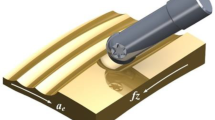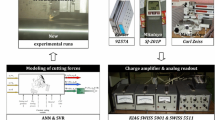Abstract
Nowadays, the manufacturing industries are continuously challenged by achieving high-quality products and clean production in order to remain competitiveness. Surface roughness is one of the important factors in evaluation of the quality of a machined part. Meanwhile, it is vital to correlate energy usage with operations being performed in the production lines for the green and energy-saving manufacturing. A novel surface roughness prediction model based on the energy consumption is proposed. Specific cutting energy consumption (SCEC) and cutting parameters are employed as inputs to the prediction model. Particle swarm optimization-support vector machine (PSO-SVM) is used to predict the surface roughness value in turning. Furthermore, this method is verified by conducting experiments in turning process and compared with the PSO-relevance vector machine (PSO-RVM). Besides, the prediction performance of the energy based model is compared with the model with different combinations of cutting parameters, energy, and vibration features. The result shows that the proposed model obtains the lowest mean relative error and indicates that the model is effective and straightforward for practical implementation.
Similar content being viewed by others
References
Plaza EG, López PJN (2017) Surface roughness monitoring by singular spectrum analysis of vibration signals. Mechanical Systems & Signal Processing 84:516–530
Salgado DR, Alonso FJ, Cambero I, Marcelo A (2009) In-process surface roughness prediction system using cutting vibrations in turning. Int J Adv Manuf Technol 43(1–2):40–51
Benardos PG, Vosniakos GC (2003) Predicting surface roughness in machining: a review. Int J Mach Tool Manu 43(8):833–844
Lu C (2008) Study on prediction of surface quality in machining process. J Mater Process Technol 205(1–3):439–450
He K, Xu Q, Jia M (2015) Modeling and predicting surface roughness in hard turning using a Bayesian inference-based HMM-SVM model. IEEE Transactions on Automation Science & Engineering 12(3):1092–1103
Mia M, Khan MA, Dhar NR (2016) Performance prediction of high-pressure coolant assisted turning of Ti-6Al-4V. Int J Adv Manuf Technol:1–13
Chen Y, Sun R, Gao Y, Leopold J (2017) A nested-ANN prediction model for surface roughness considering the effects of cutting forces and tool vibrations. Measurement 98:25–34
Panneer R, Harisubramanyabalaji SP, Sribalaji CA, Vivek A, Vigneshwaran G (2016) Prediction of surface roughness using spectral analysis and image comparison of audio signals. Int J Precis Eng Manuf 17(6):709–715
Kamarthi S, Sultornsanee S, Zeid A (2016) Recurrence quantification analysis to estimating surface roughness in finish turning processes. Int J Adv Manuf Technol:1–10
Kara S, Li W (2011) Unit process energy consumption models for material removal processes. CIRP Ann Manuf Technol 60(1):37–40
Balogun VA, Mativenga PT (2013) Modelling of direct energy requirements in mechanical machining processes. J Clean Prod 41(2):179–186
Hanafi I, Khamlichi A (2012) Cabrera F M, Almansa E, Jabbouri a (2012) Optimization of cutting conditions for sustainable machining of PEEK-CF30 using tin tools. J Clean Prod 33:1–9
Liu N, Wang SB, Zhang YF, Lu WF (2016) A novel approach to predicting surface roughness based on specific cutting energy consumption when slot milling Al-7075. Int J Mech Sci 118:13–20
Upadhyay V, Jain PK, Mehta NK (2013) In-process prediction of surface roughness in turning of Ti–6Al–4V alloy using cutting parameters and vibration signals. Measurement 46(1):154–160
Hessainia Z, Belbah A, Yallese MA, Mabrouki T, Rigal JF (2013) On the prediction of surface roughness in the hard turning based on cutting parameters and tool vibrations. Measurement 46(5):1671–1681
Acayaba GMA, Escalona PMD (2015) Prediction of surface roughness in low speed turning of AISI316 austenitic stainless steel. CIRP J Manuf Sci Technol 11:62–67
Mia M, Dhar NR (2016) Prediction of surface roughness in hard turning under high pressure coolant using artificial neural network. Measurement 92:464–474
Zhang N, Shetty D (2016) An effective LS-SVM based approach for surface roughness prediction in machined surfaces. Neurocomputing 198:35–39
Çaydaş U, Ekici S (2012) Support vector machines models for surface roughness prediction in CNC turning of AISI 304 austenitic stainless steel. J Intell Manuf 23(3):639–650
Aydın M, Karakuzu C, Uçar M, Cengiz A, Çavuşlu MA (2013) Prediction of surface roughness and cutting zone temperature in dry turning processes of aisi304 stainless steel using ANFIS with PSO learning. Int J Adv Manuf Technol 67(1–4):957–967
Vladimir V (1998) The support vector method of function estimation. Nonlinear Modeling. Springer, US, pp 55–85
Shamshirband S, Mohammadi K, Khorasanizadeh H, Yee PL, Lee M, Petković D, Zalnezhad E (2016) Estimating the diffuse solar radiation using a coupled support vector machine–wavelet transform model. Renew Sustain Energy Rev 56:428–435
Tipping ME (2000) The relevance vector machine. Adv Neural Inf Proces Syst 12(3):652–658
Acknowledgments
This work is supported by National Natural Science Foundation of China (Grant No. 71471139) and Zhejiang Provincial Natural Science Foundation of China (Grant No. LY14E050020), MITT Intelligent Manufacturing Project of China. The study of interconnection standard and experimental verification in the intelligent manufacturing plant for naval architecture and marine engineering
Author information
Authors and Affiliations
Corresponding author
Electronic supplementary material
ESM 1
(DOCX 20 kb)
Rights and permissions
About this article
Cite this article
Xie, N., Zhou, J. & Zheng, B. An energy-based modeling and prediction approach for surface roughness in turning. Int J Adv Manuf Technol 96, 2293–2306 (2018). https://doi.org/10.1007/s00170-018-1738-y
Received:
Accepted:
Published:
Issue Date:
DOI: https://doi.org/10.1007/s00170-018-1738-y




